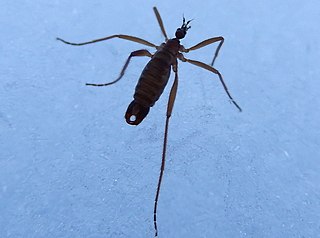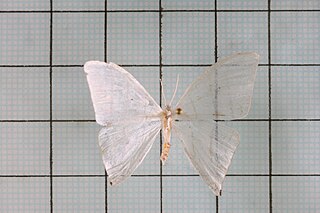
The Limoniinae are a paraphyletic assemblage of genera within the crane flies, Tipulidae, although they can usually be distinguished by the way the wings are held at rest. Limoniines usually hold/fold the wings along the back of the body, whereas other tipulids usually hold them out at right angles. Snow flies such as Chionea scita have no wings at all. Limoniines are also usually smaller than other tipulids, with some exceptions. Limoniinae are a very large assemblage with nearly 10,500 described species in 133 genera, and were historically treated as a subfamily, but their classification is in flux; numerous authors recently treated the group at the rank of family, but subsequent phylogenetic analyses revealed that the remaining groups of tipulids render the group paraphyletic. These flies are found in damp places throughout the world, and many species form dense swarms in suitable habitats.

Chionea is a genus of wingless limoniid crane flies. It consists of two subgenera, the holarctic Chionea and palaearctic Sphaeconophilus. About 40 species are currently recognized in the northern hemisphere, but there are probably several undescribed species. They are commonly called snow flies.

Ditrigona is a genus of moths belonging to the subfamily Drepaninae. The genus was erected by Frederic Moore in 1888.

Ditrigona conflexaria is a moth in the family Drepanidae. It was described by Strand in 1917. It is found in China, Japan and Taiwan.
Ditrigona cirruncata is a moth in the family Drepanidae. It was described by Wilkinson in 1968. It is found in China.
Ditrigona diana is a moth in the family Drepanidae. It was described by Wilkinson in 1968. It is found in north-eastern India (Assam) and Bhutan.
Ditrigona legnichrysa is a moth in the family Drepanidae. It was described by Wilkinson in 1968. It is found in China and Tibet.
Ditrigona platytes is a moth in the family Drepanidae. It was described by Wilkinson in 1968. It is found in China.
Ditrigona sericea is a moth in the family Drepanidae. It was described by John Henry Leech in 1898. It is found in China, Myanmar and north-eastern India.
Ditrigona fasciata is a moth in the family Drepanidae. It was described by George Hampson in 1893. It is found in Sikkim, India.
Ditrigona furvicosta is a moth in the family Drepanidae. It was described by George Hampson in 1911. It is found in India, western China and probably Tibet.
Ditrigona obliquilinea is a moth in the family Drepanidae. It was described by George Hampson in 1892. It is found in Myanmar, India and China.
Ditrigona jardanaria is a moth in the family Drepanidae. It was described by Oberthür in 1923. It is found in western China and possibly Tibet.
Ditrigona komarovi is a moth in the family Drepanidae. It was described by Alekseya Ivanovitch Kurentzov in 1935. It is found in Ussuri in the Russian Far East.
Ditrigona quinaria is a moth in the family Drepanidae. It was described by Frederic Moore in 1867. It is found in China, Tibet and India.
Ditrigona regularis is a moth in the family Drepanidae. It was described by Warren in 1922. It is found in India (Assam) and Burma.
Ditrigona pruinosa is a moth in the family Drepanidae. It was described by Frederic Moore in 1888. It is found in Darjeeling, India. The Global Lepidoptera Names Index lists it as a synonym of Ditrigona quinaria.
Ditrigona policharia is a moth in the family Drepanidae. It was described by Oberthür in 1923. It is found in China.

Chionea alexandriana is a species of snow fly (chionea) in the family Limoniidae. The species is common in the western mountains of North America, including Alberta, British Columbia, Washington State, Oregon, Idaho, Montana, Utah, and California. J.A. Chapman (1954), working in Montana, found them to be most abundant in snow fields at 3600-7000 feet elevation from November to April at temperatures ranging from 21-32 degrees F.




